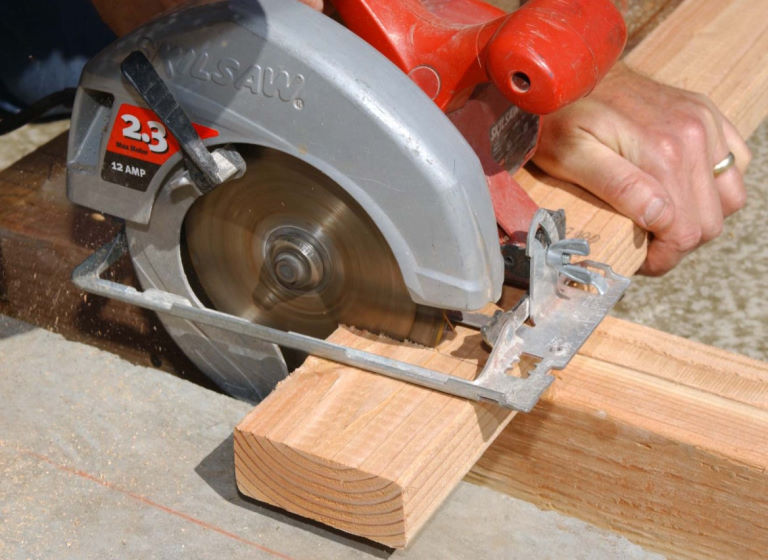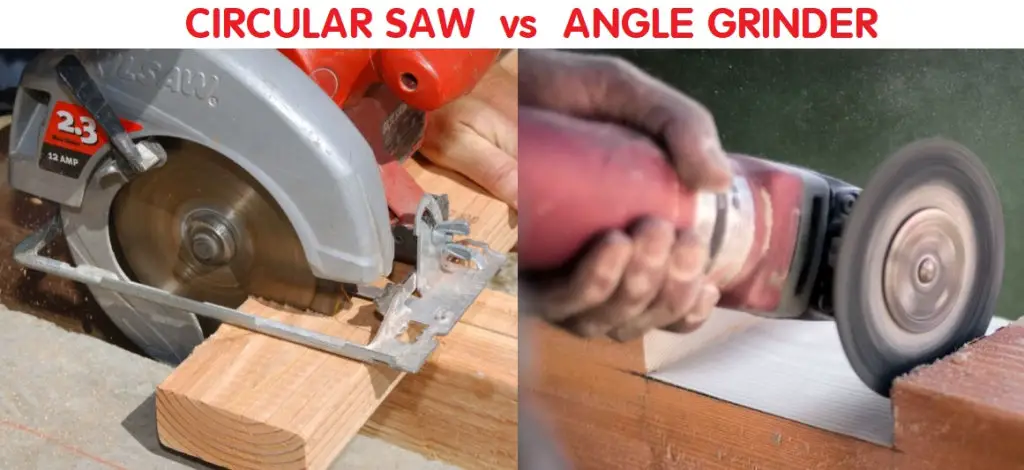It’s crucial to choose the right tool for your home projects. Some jobs are a battle of an angle grinder vs circular saw. So, how do you determine which of the tools is best for your work?
Before making the mistake of utilizing the incorrect tool, you should know their individual purposes, their basic differences as well as their pros and cons. Continue reading to learn which of the two tools is the best fit for your job at hand.
Contents
About Angle Grinders
Angle grinders are freehand tools used for grinding and polishing materials. Nevertheless, they also have other applications, making them very flexible tools.
They are available in corded & cordless versions and may be utilized on various materials, including metals and concrete. In selective cases, you can use them to carve and cut wood.
Because their blade lays flat similar to a disc instead of being straight up similar to saws, they are commonly referred to as disc or side grinders.

About Circular Saws
Circular saws are rotary tools that cut materials with an abrasive/toothed wheel. The disc is utilized to cut straight lines on wooden surfaces. You may cut various materials with circular saws, depending on the wheel you use.
Despite inferior popularity to angle grinders, circular saws can still be found in a majority of woodworking shops and on several job sites.

Angle Grinder Vs Circular Saw: Basic Differences
Even though their purposes may overlap, angle grinders and circular saws have many differences regarding their design, capabilities, and performance.
Straight cuts & rough cuts
Circular saws are designed for precise straight cuts and perform excellently in that capacity. This is not the purpose of angle grinders’ design. Instead, they are mainly designed for rough cuts, which can also be done by circular saws.
So, regarding cutting lines, a circular saw is more versatile than a grinder.

Capabilities
The capabilities of these tools are also very distinctive. While circular saws are suitable for cutting wood and making straight cuts, angle grinders can cut, but they are more suited for grinding, polishing, and sanding tasks.
As a result, the latter has a much wider variety of capabilities or projects than the former. This means that angle grinders are more adaptable than circular saws.
Working materials
Grinders are typically chosen for metal projects or cutting concrete objects with an appropriate disc attachment, while the typical working material of saws is wood.
As can be seen, the working materials of these tools are starkly different. Even though grinders can also cut wood, it’s not a common practice.
The blade’s angle
Based on which their blades are parallel, you can see their clear difference. The blade of circular saws is perpendicular to their motor, while that of angle grinders is parallel to their motor.
Their designs have a significant impact on the jobs you can do with each of these tools as well as their appearance.
Handheld or fixed
Angle grinders are designed to be freehand, allowing you to move the tools to the angle you need for sanding or polishing projects.
Although circular saws are often portable, they’re more fixed and require a firm stance to cut wood. The saws also have a guard located on the blade’s left side and a mounted metal measuring tool in order to verify that your cuts are straight.
Cutting speed
Circular saws are typically used when you need to complete a cutting task fast, especially with wood. They are built for this type of job and have the speed and precision that you are looking for.
On the contrary, angle grinders are designed for shaping and they take a relatively long time to complete a cutting job.
Ease of operation
Both tools appear to be simple to use, but they require some preparation. What sets them apart is their ease of operation in similar jobs.
Circular saws take a little longer to set up, but it’s not too lengthy, while grinders are almost ready to use right away.
Pros & Cons Of Angle Grinders And Circular Saws
To help you make a choice easier, let’s take a closer look at the pros and cons that each type of tool has.
|
Angle grinder |
Circular saw |
|
| Pros |
|
|
| Cons |
|
|
Read more: Bench Grinder vs Angle Grinder
FAQs
1. Can you put a circular saw blade on an angle grinder?
It’s not advisable for you to put a circular saw disc on an angle grinder. In fact, grinder manufacturers forbid this unsafe activity.
Because this combination lacks a base plate, the disc will uncontrollably sink in the cut. Its teeth will get caught in the kerf if the tool is twisted vertically or horizontally.
If the jamming situation is severe enough, the power tool will violently kick back to the user, which can cause serious damage.
2. Can I use an angle grinder as a saw?
Because grinders and saws are typically used for distinct purposes, you should select the one that best suits your needs, and any replacement may not be appropriate.
You should use angle grinders for cutting pavers and metal or shaping wood, and concrete, while the most suitable projects for circular saws are woodcutting.
Bottom Lines
The lack of knowledge about the differences in usage, design, and performance may lead to your confusion between angle grinders and circular saws. However, as can be seen from our article, each type is best suited to different kinds of projects.
If your jobs involve wooden workpieces, you should use a circular saw. By contrast, if your projects are sanding or polishing metal materials, you should choose an angle grinder.
